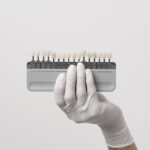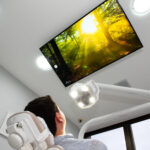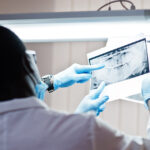TMD (temporomandibular disorder) It is a problem that affects the joint that joins the jaw, the movable bone of the face, and the temporal bone, which is fixed at the base of the skull. This joint is responsible for all mandibular movements, such as chewing, speaking, and swallowing. In combination with other organs and tissues, it is also involved in breathing, aesthetics and facial expression.
The TMJ (temporomandibular joint) has the ability to perform complex movements and involves a combination of opening and closing similar to a hinge.
People with TMD may experience pain in the orofacial region, tinnitus, clicking and limitation of jaw movements, such as locks or difficulty opening and closing the mouth.
Temporomandibular disorders can be muscular and happen when the musculature of the region becomes tense. Joint TMD appears due to joint overload due to trauma or disease. And there are also cases when both muscle and joint disorders occur.
It is estimated that about 75% of the population may experience some TMD sign, but only 5 to 7% really need treatment as they are in pain. There is a peak of occurrence of symptoms between 20 and 50 years of age, being more prevalent in women.
Main symptoms of TMD
One of the most common symptoms of TMD is pain when making jaw movements. Discomfort can be temporary or last for several months.
Pain is one of the most frequent complaints of those who suffer from dysfunctions in the region. Headaches, under the eyes, in the ears, in the face around the ears and in the neck may occur.
According to the SBDOF (Brazilian Society of TMD and Orofacial Pain), it is quite common for migraines and TMDs to happen simultaneously. In these cases, the pain is more intense and the person has difficulty controlling symptoms with available treatments.
In addition, the slaps when opening the mouth are also frequent. Those who have DTM can hear as if it were a click or creak when moving the joint. And more limited jaw movement can prevent the mouth from opening properly or moving to the side.
There are cases of people who feel their face more tired or swollen. And it's also common for them to have difficulty chewing or the bite doesn't fit properly.
These dysfunctions can greatly compromise people's quality of life if they are not treated properly. Many report tiredness or jaw pain when waking up in the morning, which interferes with the quality of sleep.
Painful conditions and limitation of jaw movement are common. Patients can increase the consumption of analgesics, have restrictions on chewing certain foods, in addition to having mood swings and even limitations in the performance of routine activities.
It is worth noting that temporomandibular disorders and facial pain can be symptoms of other health problems such as rheumatoid arthritis, fibromyalgia and even cancer. Therefore, when experiencing these discomforts, it is important to seek help from a professional specialized in the area of TMD and orofacial pain in order to have a correct diagnosis.
What are the causes?
There are many possible causes for the onset of disorders that affect the temporomandibular joint. Among them, stand out:
• Habits like clenching or grinding your teeth during the day (bruxism), resting your hands on your jaw frequently and also biting your nails;
• Trauma in the orofacial region;
• Skeletal malformations;
• Factors related to occlusion or position of teeth in the dental arch;
• Stress, depression and anxiety, as they increase muscle tension in the region;
• Genetic predisposition;
• Temporomandibular joint arthritis or damage caused by age.
TMD diagnosis and treatments
In most cases, the diagnosis is made after the person has reported the symptoms to a specialist in TMD and facial pain, usually a dentist. During the consultation, there is palpation of the musculature and joint and observation of noises with the movement of the mandible.
In some cases, imaging tests such as tomography and magnetic resonance imaging are requested.
After the diagnosis, it is important to point out that the treatment is indicated only in the presence of pain, and patients with asymptomatic crackles generally do not need therapy.
It is important that self-care information and advice on mandibular function are passed on.
During consultation, the patient should be advised to follow a soft food diet and eat slowly. You should also reduce your mouth opening, stop biting nails, chewing gum and using heat compresses in case of pain.
Professionals can choose to use a stabilizing plate made of acrylic resin in the upper dental arch overnight. This contributes to stabilizing the joint and reducing bruxism.
Below, see other therapeutic modalities indicated to reduce the symptoms of TMD:
Physiotherapy
Some massage and targeted physical exercises, in addition to heat application, can be beneficial in some cases. Cryotherapy techniques (with low temperatures) can also be applied to the face and cervical region to reduce swelling, inflammation and muscle spasm.
Medicines
The most used are analgesics, anti-inflammatories, muscle relaxants, antidepressants and anxiolytics to control pain and discomfort.
Acupuncture
The technique is performed at specific points on the face, and can reduce local pain caused by TMDs of muscular origin and relieve stress.
toxins
The application of toxins inhibits the release of a neurotransmitter called acetylcholine in the joint, decreasing muscle contraction. Reduction of muscle tone decreases pain and is indicated to control the hyperactivity of muscles in the region.
When is surgery indicated for TMD?
Rarely, specialists recommend surgery to treat TMD. It's only an option when other treatments don't work.
Generally, they are indicated in severe cases of degenerative problems, for joint remodeling or reconstruction to restore mandibular movement and mitigate pain.
Surgery has precise indication and in specific cases such as fractures and presence of tumors, for example. Well-conducted conservative clinical treatments are always superior to surgical options in cases of TMD.
Special cares
Those with chronic pain need to avoid anything that overloads the musculature and jaw joint. Therefore, try not to clench your teeth during the day; try not to sleep on your stomach, as this can strain your jaw and neck muscles; avoid eating very hard foods; and maintain good head, neck and back posture as this will help relax the muscles of the masticatory system.
Do you have questions? Talk to us
The later the patient looks for a professional, the more the condition can evolve to a degree of severe mandibular fractures that are difficult to treat.
So, in the face of suspected DTM, contact us and schedule your appointment!
Want to stay on top of more guidance? So like our pages on Instagram It is Facebook.








 per
per